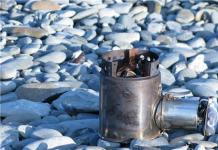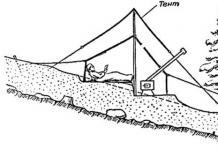In each gas boiler, regardless of its model, the gas burner is the main working unit. Its function is to ensure the rapid preparation of a special air-fuel mixture, followed by its entry into the combustion chamber, as well as maintaining a stable flame throughout the entire period of operation of the heating equipment. It should be noted that the reliability of operation, as well as the efficiency of fuel consumption, is determined precisely by how high-quality a gas burner for a gas heating boiler is installed in this model. Therefore, when choosing a boiler, it is imperative to study the type and features so that the characteristics meet the requirements.
Device
Complete combustion of fuel, accompanied by efficient heat transfer, is possible only with the correct ratio of the mixture of air and gas. Such a fuel mixture burns with an almost colorless flame that has a characteristic bluish tint. When it burns, the maximum heating temperature is observed.
According to the method of intake of air and oxygen, their mixing, as well as the technology of forming a flame, experts distinguish several types of gas burners. However, as a rule, preference is given to only two varieties - atmospheric and fan. When choosing one of these types, it must be borne in mind that an atmospheric burner will need a chimney to constantly maintain natural draft, and when operating ventilation burners, you only need to bring the coaxial chimney outside the building.
In order for heating equipment to work efficiently and without failures, in addition to the combustion process, it is necessary to control the output thermal power. Therefore, the main parameter of burners for a gas boiler is power control technology. Depending on this characteristic, the following types of devices are distinguished:
- Single-stage - devices can operate exclusively in the mode of complete combustion of the incoming gas. Their advantage lies in a simple design, as well as a low price. However, they have increased fuel consumption and sharp jumps in the temperature of the coolant inside the heating boiler.
- Two-stage - devices in which it is possible to work both at maximum power and by about 40-60%.
- Modulation - in such equipment, a two- or three-stage method is combined with a smooth adjustment of the gas supply. In it, you can change both the combustion field and the size of the flame of the torch.
- Equipment with a smooth change in the size of the flame torch - the volume of gas that is supplied can be adjusted to the full volume of the burner.
Features, pros and cons of atmospheric burners
The functioning of the burner is similar to the mechanism of operation of a simple ejector, in which the gas-air mixture is prepared from gas and air coming directly from the room. The combustion field consists of several parallel rows of channels with separate nozzles.

The popularity of atmospheric burners is due to the fact that these devices have a number of important advantages:
- Simple construction;
- Compactness;
- Affordable price;
- Silent operation;
- Adjusting the output power of the burner does not require special skills;
- Easy installation technology;
- Lack of energy dependence;
- Maintenance can be performed independently at home.
But when choosing such equipment for heating a house, it must be taken into account that a chimney is required for operation, and the quality of its work directly depends on the shape of the individual elements and the correctness of its installation.
Features, pros and cons of fan burners
These devices are characterized by a complex design and an automated control system, which ensures almost complete control of all processes in heating equipment.

Among the main advantages of burners of this type should be noted:
- The ability to adjust the power of work in a fairly wide range;
- Ensuring full control of the preparation of the gas-air mixture;
- Fuel combustion control;
- Economical fuel consumption;
- The device helps to increase the efficiency of the gas boiler;
- Can be used in buildings without a chimney;
- There is no need to reconfigure or change the design of equipment for the use of fuel of the combined composition.
However, there are also disadvantages: volatility, high price, additional installation of a voltage stabilizer and UPS, the need for the help of service centers to perform maintenance.
Automation
Tasks such as preparing the fuel mixture or regulating the combustion process are performed due to the design features of the burner, the size and shape of the outlet nozzles and nozzles. The automation of the device is designed to perform the following functions:
- Setting the optimal thermal power;
- Constant support for the combustion of the igniter;
- Ignition of a spark flame by a spark gap or a special piezoelectric element;
- Pressure regulation inside the gas pipeline;
- Control of changes in the temperature of the heating system;
- Provision of traction;
- Elimination of violations in the functioning of the fan;
- Response to flame extinction;
- Shutting off the supply of natural gas in an emergency;
- Sending a signal about the problem to the display.
Setting
Performing the adjustment of atmospheric burners consists in adjusting the location of the damper for the flow of air, as well as adjusting the position of the jet responsible for the dosage of gas, and the nozzle. When the burner is working properly, the flame is uniform with a bluish tint.
If a fan-type device was selected, then the initial setting will only be needed for a damper at the inlet of air flows to control their volume. The minimum requirements are due to the fact that the system is automated and equipped with an electronic control unit, which almost completely eliminates manual control of the mechanical components of the heating equipment. In addition, in such burners there is a gearbox responsible for the normal composition of the gas-air mixture at the inlet.
Popular Models
Many companies are engaged in the production of gas burners for heating. Therefore, on the market you can find devices of various models that differ from each other in design, parameters, operating principle and technical characteristics. Among the most popular models of domestic production, the Hearth, UGOL-P, KCHM and Kupper are noted.
In addition, users often prefer burners from foreign manufacturers: Lamborghini, Cib Unigas, Buderus, and Weishaupt.
 Gas burner for the boiler Cooper AGG-26K
Gas burner for the boiler Cooper AGG-26K How to clean?
During active use, the devices should be regularly maintained, including cleaning. If their design includes a fine filter, then it must be changed or cleaned. In the absence of this part, the nozzles are cleaned from dirt, dust, and oily substances.
This procedure is carried out using compressed air, the pressure of which should not exceed the values specified by the manufacturer. In addition, many use normal airflow. The nozzles are cleaned with a polymer brush with a short bristle of medium hardness. Additionally, it is recommended to use special detergents. Over time, the internal cavity of the outlet nozzles also becomes clogged with foreign substances, so it is imperative to check their condition as well.
When choosing a gas burner for a gas boiler, it should be borne in mind that atmospheric devices are much easier to clean, because the design is completely disassembled. This can be done even at home. But for maintenance of fan burners, it is necessary to contact the service center.
Today, more and more home owners, when choosing a heating system for their own home, prefer solutions based on a boiler. We are talking about gas boilers, although some people prefer electricity or wood. And the gas option is popular due to the fact that this type of fuel is one of the most affordable. Yes, and its consumption will be significantly lower than that of similar options. But the effectiveness of the described device will largely depend on the good performance of such an element as a burner.
Device and principle of operation
In order to completely burn the gas and get the maximum amount of heat from it, it should be mixed with an air mass that has a certain content of oxygen, which is an oxidizing agent. The ideal mixture in the final should burn with an almost colorless fire with a hint of blue and a maximum temperature. The gas burner will be responsible for this entire process. If we talk about its device, then it cannot be called complicated.
Any burner consists of the following elements:
- nozzles;
- ignition mechanism;
- a sensor that monitors the presence of a flame;
- automatic temperature monitoring system.


It should be noted that modern designs must meet certain requirements:
- long period of use;
- silent operation;
- complete combustion of the gas.

In older models of boilers, burners were used for a long time, since then rather high demands were placed on the quality of materials and the elements themselves. Now many technologies and materials are not used, and the quality of the burners has fallen somewhat. Experts recommend buying products that are manufactured by well-known companies that use high-quality spare parts.
If we talk about silent operation, then this is a really important point. Many people remember Soviet-made instantaneous water heaters, where the noise of the flame was great. And the models produced now are quite quiet.


When choosing a boiler, it is necessary to pay attention to ignition. It should be carried out without pops and other noise. This is a very important point, because there is no way to adjust it. Therefore, if the burner behaves in this way, it is not worth buying it. The design of the combustion chamber will also affect the noise level.
The third point to be mentioned is complete gas combustion. This is also important and should not be neglected, because the burner must burn gas in full with the least emission of combustion products and other compounds, including carbon monoxide. At this point, other parts of the gas-fired equipment will also be affected. It is also necessary to equip a good exhaust gas with a chimney with excellent draft.

The essence of the operation of the burners is simple - the fuel enters through the ejector. The fuel supply rate will be very high and for this reason a low pressure is formed, which allows air to mix with the gas. The resulting mixture goes through the tubes to the holes, thanks to which it ends up in a special firebox, where it is ignited using electric ignition.
Varieties
Now let's talk about the categories of burners. It is better to use the model that is indicated by the manufacturer in the regulatory documentation. The heat exchanger, like the design of the boiler, is usually created with the expectation of installing a specific burner.
If we take the purpose, then there are two categories of burners.
- For high power industrial boilers. Injection fan burners are usually mounted in this category. Their performance will be from 120 to 250 kW.
- household options. In this case, the power will not be more than 120 kW. This includes an atmospheric boiler burner. Its disadvantages are high fuel consumption and serious installation requirements.


If we talk about the type of fuel, as a classification criterion, then there are two types of burners:
- operating on liquefied gas;
- on a natural analog.


The difference between the types of burners will be in the gas operating pressure and nozzle sizes. In household designs from European brands, universal options are usually installed that can work with both types of gas.
There are also injection diffusion and other solutions with preliminary partial or 100% mixing. But such options are used only in industrial models. It should be noted here that the type of burner will affect the design features of the heat exchanger, combustion chamber, gas outlet option, and exhaust system.


According to the type of burner regulation, there are:
- 1-speed;
- 2-speed;
- 2-speed modulated gas version;
- modulated.



The control type determines whether an open or closed burner will be used. The category of the device will affect the standards that will apply to the installation and operation of such a boiler.
Now let's talk more about each of the categories. One-step solutions are the most common option. Their principle of operation is that they turn on and off. The frequency of changing operating modes will depend on how quickly the coolant cools, as well as on the mode of operation.

The features of these burners are:
- work regardless of the availability of electricity;
- high gas consumption;
- excellent reliability;
- the presence of an ignition mechanism.

If we talk about two-stage burners, then they are suitable for boilers where there is precise regulation of gas flows. By the name, you can understand that such a device can work in two modes. Usually we are talking about 30 percent and 100 percent of the power.
The features of this solution will be:
- constant burning;
- heating of the heat carrier by one hundred percent;
- models with automation control the transition from one mode to another.


The last type is modulating burners. They are considered the most economical. Changing the burner power is usually carried out in auto mode.
Features of the modulating burner are:
- the presence of automatic control;
- universality;
- high economy.

Choice of burners for different types and models of boilers
When choosing a burner, you should pay attention to its various characteristics - the fuel supply model, the option of mixing gas with air, compatibility with various categories of devices. We will talk about the most interesting models.
- Burner KCHM. It is used in boiler units converted from conventional fuel to LNG or conventional gas. It usually has automation, and there are three nozzles. It is used in boiler units of the "Kontur" model or similar options.

- Burner "Hearth". It is a pneumomechanical type device with an automatic mode of operation. It turns itself off if:
- the fire went out;
- gas supply stopped;
- there is no necessary traction.
This model has a gas pressure controller. This makes it possible to achieve an equal burning of the fire, even if any malfunctions occur in the mechanism. Such solutions are easy to maintain due to the fact that soot does not accumulate in the convective part.

- Another burner that I want to talk about will be the model "Cupper". This option is universal and suitable for combined boilers, solid fuel structures from Kiturami or Russian-made models of the Conord brand. The advantage of this burner will also be the possibility of its installation without plumbing or welding.
- Another quite popular solution is burner for DKVR. Such a block device is used where there is forced air supply. This solution is used for steam boilers for industrial use and having the appropriate power. Their efficiency is about 94-95 percent. This design works either in diffusion or inflatable version. To increase its efficiency, powerful Italian fans are often used.


- Another category is burners for KVS. They are used for domestic needs and are solid fuel. Considering that there is no need to use too powerful equipment for space heating, atmospheric or injection solutions are used. When selecting a burner element, attention should be paid to the power and safety in use.

How to do it yourself?
Consider an example of manufacturing a gas burner for a solid fuel boiler unit. It is better to use a valve from an oxygen cylinder, made according to the standard, VK-74.
To create a burner, you must perform the following steps.
- Equip the branch pipe at the outlet with a fitting, which will be connected to the reactor with a hose.
- We mount a cap on the inlet pipe part connected to the cylinder, where there is a small hole for connection with the jet. It can be found on the stove or in a blowtorch.
- Now a pipe made of steel, one hundred millimeters long and two millimeters thick, is welded to the cap.
- There should be a distance of one and a half centimeters between the nozzle and the cap, through which oxygen will be accessed. For this reason, you first need to attach 3 small pieces of wire to the cap, and then the pipe itself.
Gas burners for boilers provide combustion of fuel to generate thermal energy. In fact, these products, together with the heat exchanger, are the main part of the gas-fired unit. The simplicity of the design does not negate their versatility and functionality. It is very important to have an idea about the design of the boiler burner in order to choose the right heating equipment at the time of purchase.
Any device designed for burning liquid and gaseous fuels has a main unit - this is a burner. She is responsible for the formation of a uniform flame. The fuel mixture can be of different quality, but a well-thought-out method of fuel supply will ensure complete combustion of any combustible mixture.

The most important indicators of a high-quality device for gas combustion are silent operation and the absence of emission of harmful compounds during fuel combustion, in particular carbon monoxide. A modern household gas burner for a heating boiler is a simple device that has gone through a long process of modernization. Some of the old designs produced during the Soviet era made a lot of noise and were far from safe, especially in strong winds.
Many indicators, including the noise level, are affected by the design features of the combustion chambers. In the new burners, a lot of attention is paid to the convenience of ignition and uniform flame supply. The design features of a gas burner for space heating are very simple:
- gas ignition is provided by the ignition system;
- the gas is ignited in the nozzle;
- automation is designed to control the main indicators: temperature, gas distribution uniformity, emergency shutdown;
- the presence of fire is controlled by a special “flame sensor”.
From the room, by-products of gas combustion must be removed to the outside so that harmful impurities do not fill the space. To remove gas, a chimney with good draft is required. This is the only drawback of gas heating. The gas burner device itself is constantly being improved, including the following indicators:

- heat generation schemes;
- rational supply of oxygen;
- ways to remove soot and carbon dioxide.
Gas burners for boilers: basic requirements and scheme of work
The heat released during the combustion of gas is concentrated in the heat exchanger, from where it is transferred to the coolant. Together with a small amount of heat, part of the combustion products is released into the atmosphere. A chemical reaction of heat release takes place: at a high temperature, the burning gas combines with oxygen coming from the air. The principle of operation of a gas burner is based on the combustion of gas and the release of heat. Water vapor and carbon dioxide are by-products of a chemical reaction that produces heat.
Among the hazardous substances are nitric oxide, carbon monoxide and some tar components. Because of this, special requirements are placed on the hood and chimney - good draft is important.
According to modern requirements, in any mode, gas burners for heating boilers with automatics (and other varieties) should be of low toxicity. It is required that only slightly toxic gases and a small amount of soot are released during combustion, which is a general condition for the use of most types of raw materials for heating.

Basic requirements for a burner for a boiler:
- availability for self-installation;
- understandable design scheme;
- long period of operation;
- operational reliability;
- insignificant noise threshold;
- convenience of switching modes;
- the ability to work on a different type of fuel;
- complete combustion of gas;
- high environmental performance (little harmful combustion products are emitted).
Helpful advice! In order to extend the life of the equipment by carrying out timely repairs of the gas burner for the boiler, it is important to purchase components only from trusted manufacturers.
As you know, a cheap product indicates a low quality product and a short service life. Often, repairs are impossible, especially if there is no warranty period and a factory certificate. There are always high-quality household gas burners for heating boilers on sale. Their price is quite acceptable for most consumers.
The main varieties and classification of gas burners
For a long period, there was no particular abundance of this type of product on sale. The simplest boilers, titans and gas water heaters were in short supply. The appearance of a gas burner for an automatic boiler was regarded as something fantastic. But these appliances also needed ventilation with a full chimney. Nowadays, even mobile infrared picnic burners powered by gas are offered.

Modern fuel units are very diverse. Their advantage is the almost complete combustion of fuel and the absence of toxic impurities during operation in closed conditions.
Traditional heating equipment is characterized by design variability:
- atmospheric boilers;
- universal;
- low temperature;
- turbocharged;
- fan;
- injection;
- gas burners with piezo ignition.
Do-it-yourself devices are also far from uncommon. Homemade gas burners can be assembled using the drawings, diagrams and sketches of the masters containing detailed descriptions, as well as watching the video.
The boilers have different types of flame ignition - using a piezo lighter and using a spark when the electronics are triggered.

It is important! Piezo ignition - a single ignition, after which the flame is maintained in operating mode as long as there is a gas supply. This device should not be confused with burners for a gas stove (nozzle with a divider) and a grill.
The electronic ignition must be activated during the start of the supply valve: the gas is ignited by means of an electrostatic spark. This option is considered the most economical and reliable, but during power outages, the boiler is often idle (if there is no alternative way to ensure it is turned on).
Gas burner with piezo ignition and other methods of maintaining the flame
The variety of burners is determined by a number of features, including the method of air injection and the design features of the furnace itself, which can be:
- open (air comes from a heated room, supply ventilation is needed, combustion products are discharged into the chimney);
- closed type.

Low-temperature gas burners (atmospheric) are mainly used in open furnaces. They are distinguished by a simple device and a well-established principle of operation. The gas supply to the wick is carried out by means of an ejector. In this case, the air comes directly from the boiler room, where the heating equipment is installed. When ignited, small low-temperature flames are visible.
This type of gas burners for furnaces and boilers is distinguished by its low noise level, availability and versatility. Such a device can be adapted for combined fuel stoves, modern specialized equipment and primitive old-style boilers.
The principle of operation of a gas burner with piezo ignition is quite simple, especially if the operating parameters of the heating circuit are set. The sensor detects a decrease in temperature, the stop valve and ignition are activated. The blue fuel entering the burner ignites, releasing heat.
The implementation of flame control in gas equipment occurs in different ways. In some units, everything looks very primitive, others are equipped with electronics. Sometimes complex schemes are used even when upgrading old equipment using a do-it-yourself gas burner for a boiler.

Attention! If this is an inexpensive burner, then, in all likelihood, it includes a simple thermoelement that will require an early replacement.
Advanced boilers with "smart" options are equipped with an ionization controller that is sensitive to changes. This guarantees gas shutoff in the event that the flame goes out and there is not enough oxygen for the combustion process (fuel runs out).
The electronics also respond to increased concentrations of foreign matter in the blue fuel itself and the by-product of combustion. The gas will be shut off (this is thought out in the SABC gas burner), and the ventilation will start to work at full capacity.
Helpful advice! Before cleaning the burner of a gas boiler, it is important to understand its structure by studying the technical documentation containing a description of the operation. Each type of product has its own design differences.

Atmospheric boiler burners and manual gas burners
Work due to the influx of oxygen in a natural way gives a full-fledged combustion of fuel, the removal of combustion products is carried out through a conventional chimney. The operation of the equipment has been simplified with the use of atmospheric devices and special nozzles for gas burners.
Attention! The only condition for the operation of the device on oxygen taken from a heated room is excellent supply ventilation.
Important advantages of boilers with atmospheric gas burners:
- independence from power sources, which is important when working in rooms without electricity;
- high reliability (no complex components that require frequent repairs);
- low noise threshold;
- constructive simplicity;
- affordable price.
Important! Information for those who are interested in how much a gas burner of the simplest sample costs - its price starts from 250 rubles. And the cost of a gas burner ugop-P-16 "Coal", for example, is approximately 1000 rubles.

The disadvantages of atmospheric units include:
- the need for a full-fledged chimney that removes smoke and fuel mist to the outside;
- relatively low efficiency (compared to modernized samples);
- the probability of incomplete combustion of fuel with a lack of oxygen;
- the difficulty of adapting to other heat sources;
- the need to install forced ventilation or a small window.
Helpful information! Burners with electronic ignition require a mains-operated high-voltage converter. In this they differ from such simple devices as manual gas burners.
Use of ejector burners in finished and converted boilers
A combi boiler with a ceramic gas burner justifies the expense with its versatility, although it is considered an expensive option. Far from budget equipment has a lot of advantages, including autonomous furnaces:
Related article:
Types of boilers. Varieties of gas boilers, their features, replacement and installation. Top 10 gas boilers.
- for solid fuel;
- with gas burner.

With such equipment, you can easily switch to coal and firewood, usefully utilize any organic matter. This is a good opportunity to save on gas, especially in a private house, where you can always find something to recycle.
To supply gas to the burners, additionally equipping them with automation, wood-burning boilers are often equipped with special nozzles or wicks. For these purposes, a simple atmospheric or ejector burner (with air suction) is suitable. At the same time, the entire boiler does not need to be redone, since the rest of the boiler functions according to the same principle: fuel is burned in order to obtain thermal energy to heat the coolant.
Helpful advice! For old domestic equipment, atmospheric gas burners are more suitable, since complete tightness cannot be achieved in them due to design specifics.
Equipment for automatic provision of the combustion process in combined boilers can be purchased additionally if it is required to convert a wood-burning furnace into a gas boiler. Some models of solid fuel boilers, including pyrolysis ones, are equipped with a gas burner, the flame of which is necessary for ignition.

Fan or forced air burner
The furnace of some devices has a built-in fan (air blower). Its function is the forced supply of oxygen to the ignition chamber. In this case, the oxygen supply is forced, the volume is controlled automatically.
This is the need for closed-type chambers, where there is no free access to the air mixture, which creates conditions for a higher temperature of the gas burner. The lack of natural access is compensated for with a simple fan-type device.
Such burners have their pros and cons. But they are not so versatile, since artificial injection has to be used, which requires additional energy consumption. An important advantage is that the fan devices are fully adapted to automate the operation of the boiler. In such models, a mixture of fuel and oxygen is obtained directly at the outlet.
Multi-block gas burners for space heating with air transport by means of a fan have the following structure:

- fan relay that turns off the burner when the blade motor stops;
- pressure regulator;
- block filter;
- burner on/off valve (when pressure changes);
- fuel consumption option;
- reducer;
- uninterruptible power supply (needed in case of a sudden power outage, but not all devices have it).
Note! Pneumatic or fan burners are often part of the boiler room equipment with a fairly high threshold of automation, which is necessary to avoid serious accidents.
The servomotor controls the position of the damper, so there is no need to adjust the burner and additionally monitor the operation of the boiler. The regulation of the portions of the incoming oxygen necessary for proper combustion occurs automatically.
A significant drawback of this type of gas burner is the price due to the complex design of the product.

Gas burners are not suitable for "homemade", especially when they want to convert a solid fuel boiler into a universal unit, and its heat exchanger requires good insulation. The burners here are volatile, most often they are equipped with a backup power source.
General classification of gas burners by type of fuel
Country houses can not always be provided with natural gas supplied from a common highway. Therefore, the variability of the burners in terms of the use of different types of fuel is provided. If the fuel comes from a gas main, propane-butane gas burners are most likely used for heating boilers.
Main gas-methane is the most affordable natural fuel for boilers. However, now there is no big benefit in the price of liquefied blue fuel (propane-butane mixture). General heating provided by the main pipeline is also expensive.
Gas boilers operating on different types of fuel mixtures have approximately the same design. There is a slight difference in cost, but it is also insignificant (equipment for liquefied fuel will cost more). The burners themselves are slightly different, having different nozzles for liquid fuel and blue gas.

Propane burners require adjustment to this type of fuel with the installation of a jet. When burning, the flames give off a yellowish color, soot accumulates more in the chimney. The jet is responsible for normalizing the pressure.
Modern burners operate in a wide temperature range - from -50 to +50 °C. Part of the equipment can be adapted for other types of energy carriers:
- waste oil;
- diesel fuel;
- fuel oil;
- kerosene;
- propanobutane base;
- arctic diesel fuel.
Modern fixtures often come with both types of nozzles or universal equipment for fuel varieties, which makes them easy to reconfigure.
Attention! Some craftsmen offer gas burners for boilers with their own hands (for solid fuel equipment).

It is safer to purchase simple gas equipment adapted for gas in cylinders. Homemade equipment, although more affordable, but unsafe! Usually carry out "alterations" on the basis of old units.
Turbocharged types of gas burners and their design differences
Among modern gas equipment, many experts prefer closed-type burners for turbocharged boilers. They are self-sufficient in terms of design, suggest the presence of a compact chimney, which can even be diverted into general ventilation with autonomous heating.
The heating unit with a special closed-type combustion chamber receives oxygen from the outside - through a special supply pipe (coaxial chimney). In approximately the same way, combustion products are removed to the outside. Heating equipment is controlled by a sufficiently powerful fan on automatic control.
This is interesting! A coaxial chimney is a device created on the principle of "pipe in pipe". A turbocharged boiler can even work in a bunker or other sealed room without windows and a ventilation shaft.

Such a device is much more expensive than atmospheric heating equipment. However, for an additional fee, the buyer receives a number of benefits, including autonomous operation in a residential area. This device, thanks to automatic control, has a high level of security.
Turbocharged equipment has the highest efficiency and a flexible temperature scheme. Fuel burns almost completely, which is important for environmental performance. There are also disadvantages, including structural complexity, causing difficulties during installation and repair.
Gas burners for combined equipment are most often used in solid fuel boilers. This is a rather complex unit, so all nodes must meet certain requirements for efficiency and safety. The automatic device is able to switch from one type of fuel to another for uninterrupted heat supply. According to this principle, pellet and pyrolysis boilers are arranged, equipped with gas for burners, which drives the ignition process.
How to choose the right gas burner for a stove or boiler
Gas equipment with improper operation is associated with a certain risk. It is necessary to correctly select a furnace gas burner (nodal parts), and for this you need to have a general idea of \u200b\u200bthe design differences between the devices. When buying, it is important to know what types the product is divided into according to the method of burning fuel in the boiler:

- atmospheric burner;
- inflatable.
Not every manufacturer should be trusted, it is better to purchase from authorized dealers who provide certificates and all technical documentation. In the event of the acquisition of low-quality components or assemblies, there will be someone to file a claim with.
Gas-fired heating equipment is distinguished by various features, including the method of ignition and flame adjustment. When buying, experts recommend paying attention to the following indicators:
- heat generator power;
- exactingness to the quality of the gas mixture;
- the possibility of automatic regulation;
- the authority of the company and the country of origin;
- price-quality ratio".
Burners for floor boilers are available in the following versions:
- atmospheric;
- supercharged,
- piezo;
- electronic.

According to the power adjustments, you can choose a burner:
- 1-speed;
- 2-speed;
- with a smooth transition
- with automatic adjustment.
The flow of the gas mixture in different boilers is:
- straight-through;
- twisted (more powerful).
The most popular are gas burners for German-made boilers (Buderus, Vaillant), Slovak (Protherm) and Italian (Lamborghini). Among the products manufactured by domestic companies, Lemarks, Vakula and Conord equipment have proven themselves well. Among industrial devices - burners of the "Impulse" series.
The duration and productivity of any unit depends on the right choice and proper operation. Gas equipment is purchased not according to the principle where it is “cheaper” or “more powerful”, but according to the existing type of boiler.
For the boiler is its most important component. The operation of the boiler, its efficiency and productivity depend on the choice of this component.
The demand for such burners is quite large, since the type of fuel that they use is considered one of the cheapest today. There is a wide range of gas burners. Therefore, in this matter, you need to be careful and take into account all aspects.
Gas burners for boilers are structures inside which gas and oxygen are mixed. The mixture enters the exit holes and there it is ignited by a spark or a piezoelectric element and a stable stable torch is formed.
The main task of the listed elements in boilers is to maintain a stable and constant combustion of the resulting mixture. As you can see, the design of the boiler with a gas burner is quite simple and its installation will not cause difficulties.
It consists of several units: a nozzle, an ignition system, an automation system and a flame presence sensor.
Its structure must be, first of all, safe. In addition, this element of the heating boiler must burn the mixture without residue, and the emission of harmful substances should be minimal.
Low noise level is another requirement for devices. Be sure to pay attention to the service life.
Gas burners of heating boilers with automatics are another safety requirement. As soon as the fire goes out, the fuel supply is automatically cut off. This is one of the main criteria for her selection.
They have found their application in household heating stakes and in industry. Gas, despite its high consumer qualities, has a fairly low cost compared to other types of fuel. This makes gas burners in demand and popular.
Atmospheric gas burner.
To date, gas AOGV boilers are of great interest - heating gas water heaters. A distinctive feature here is the volatility of boilers, that is, they can work without an electrical network.
In addition, the noted devices are fully automated by the automated control system, which plays the role of an automatic temperature controller and reduces the amount of fuel consumed.
Classification of gas burners
Main types: atmospheric / injection, blast / ventilation, and diffusion-kinetic. The first is characterized by an open combustion chamber. Air is supplied by being sucked in by a gas stream.
Atmospheric gas burners are a tube or several pipes where fuel is supplied. A low pressure is formed in the tube, due to which air is sucked in from the room. Such burners are usually part of the boiler.
Most often, atmospheric gas burners are used for domestic heating boilers. The area they can heat is no more than 100 sq.m. In addition, heaters can be used in boilers of various types - from expensive to cheap designs.
Blast gas burners for a heating boiler have a more complex design and principle of operation.
Ventilation burners have a closed combustion chamber. Here, air is supplied by a fan. Thus, it becomes possible to set the flow rate of the gas-air mixture. This in turn leads to high efficiency values.
Blast burners must be purchased separately from the boiler, as an additional unit.
These burners for heating boilers have their advantages. Firstly, it is safety, since they have a closed combustion chamber. The second advantage is the high level of efficiency. Blast gas burners for boilers are insensitive to pressure changes.
They also have their drawbacks: a high noise level compared to atmospheric ones, high energy costs, and the high cost of the device itself.
As for diffusion-kinetic gas burners, they occupy an intermediate position between atmospheric and blast ones. Air is not completely supplied to the chamber, after which it is added to the flame. They are not used in domestic boilers.
This type of burner has its pros and cons. The main advantage is considered to be the achievement of the maximum value of efficiency. The downside here is the high cost.
Other differences
In addition to the above, depending on the type of adjustment, there are other types. These include single-stage, two-stage, smoothly-two-stage, modulated.

The structure of the gas burner.
The principle of operation of single-stage gas burners is to automatically close the gas valve as soon as the coolant reaches a certain temperature. Thus, the gas burner is automatically extinguished.
After the gas reaches the temperature of the lower limit, the gas valve automatically opens, which leads to the complete ignition of the burner. Such devices are very convenient to use in gas household appliances.
Two-stage gas burners for the boiler operate in two systems - at 40% and 100%. The burner starts to work at 40% immediately, as soon as the coolant is heated to the desired temperature, and the gas valve is closed. The automatic system allows you to switch from one system of work to another.
Infinitely adjustable two-stage gas burners operate in two modes. Here, the transition to another mode is carried out more smoothly than in two-stage ones.
With continuous heating of the boiler, modulating burners are used. Unlike a boiler with an atmospheric burner, this type of burner captures a wide power range. In addition, modulating options save gas significantly.
Due to the automation of the process, the service life of such units is much longer. Flame height for modulating type heating is adjusted automatically.
In turn, modulated options are classified depending on the principle of operation of the modulating units.
Allocate burners with modulation:
- mechanical;
- pneumatic;
- electronic.
Burners with electronic modulation provide high control accuracy. To date, modulated Italian-made gas burners are considered the best.
Gas burners for universal boilers
Why do we need universal boilers? In fact, such fuel for solid fuel boilers as firewood, pressed straw, are quite low in price. If one type of fuel rises in price, you can easily switch to another.
The design and principle of operation of a gas burner for universal boilers are more complex. Burners for solid fuel boilers transfer fuel from one type to another. The efficiency of the gas boiler depends on the choice of burner.
Types of universal boilers using a gas burner
Consider the example of a universal firewood-coal-gas boiler. In such boilers, atmospheric is used, where gas and air are mixed naturally. You can also use a blower system equipped with a fan.
Which one to choose is up to the buyer, but it should be mentioned: fan models are volatile and noisier.
An automated gas burner is performed using a fan circuit. Gas and air are mixed in it, after which the resulting mixture enters the nozzle and ignition occurs.

Design features of the burner for a gas boiler.
A fan, a gearbox and an automation system are built into the side of the burner, with the help of which the gas burner is adjusted.
Today, the most famous are the universal gas / diesel boilers, since the structure of these substances during combustion is very close. This makes switching to another fuel quick and easy.
There are also more expensive models of universal boilers that operate on many fuel options. For example, boilers wood-coal-electricity-gas-liquid fuel. Here one type of fuel is the main one. It is on the basis of it that the power of the boiler is calculated. Accordingly, other types of fuel are secondary.
The use of a liquid fuel element will lead to a decrease in the efficiency of heating equipment. During the heating of firewood, diesel, briquettes, the heat rises from the bottom up and heats the coolant. If a burner is used, it spreads horizontally.
As a result, the rear wall of the boiler is exposed to the greatest effect of heat. After a long period of use, it may burn out.
Additional insulation will help solve this problem. Diesel fuel must be stored in appropriate places. These include plastic containers, rooms with a protective pallet. Sometimes it is buried, next to the boiler room, if the soil allows. The issue of storage should be thought out in advance.
Universal boilers are often used in car services. If the object is located in a place without access to the gas main, then universal heating devices will be an excellent choice.
As fuel, you can use not only firewood, coal or pellets, but also waste oil. This fuel provides a fairly high efficiency.
At the same time, the consumption can vary significantly depending on the power. A sufficient supply of this material is required, which is possible only with a large turnover.
Switching from heating one type of fuel to another is sometimes simple, and sometimes laborious. Switching from diesel to LPG can be a particular hazard. The first, as a result of prolonged operation of the heating system, leaves soot in the chimney.
After switching to gas, it can crumble and block the chimney. Then carbon monoxide can enter the room, which is fraught with serious consequences.
Of course, the burner in this case should turn off automatically. Nevertheless, it is not worth risking your life and it is better to turn to specialists. They will definitely, after changing the heating mode, clean the chimney.
All the above transition conditions are typical only for single-furnace systems. Their design provides for the combustion of fuel in one chamber. On the one hand, such a device is the most economical. If you do not plan to change modes frequently, then overpaying does not make sense.
According to the materials used, boilers are divided into cast iron and metal. The first option is the most reliable. Their design allows them to withstand severe thermal loads. They are able to provide a long service life even at high working capacities.
The disadvantage of the devices is their bulkiness and weight. During the selection, it is necessary to think over in advance all possible options for operating the specified heater.
Two-furnace boilers are more practical and easier to use. Especially when it comes to frequent switching from one type of fuel to another. At the same time, they have significant dimensions. The fireboxes in them can be located in different ways: next to each other, one above the other.
In this case, the same coolant circuit is heated with different types of fuel, and the transition is carried out without additional installation work, manually or automatically, depending on the additional equipment used.

The device of a gas boiler with a burner.
Each compartment is made specifically for a specific type of fuel. The result is high efficiency and economy due to the change of operating mode. The transition from one work option to another does not cause any difficulties. In some models, it can be done automatically.
These heating systems are especially effective in conditions of power outages, unstable gas supply, and the high cost of connecting to the main.
Given the availability of solid fuel materials and their relatively low cost, they have no equal. On the other hand, the price of a universal system is quite high.
Homemade units
There are craftsmen who remake heating systems with their own hands. On the Internet, you can even find the necessary schemes for changing gas burner devices, their installation and adjustment.
Usually, metal is used as a material for the manufacture of heating systems. A cast iron firebox would be much more reliable. However, it is not possible to use it at home.
An excellent option for manual work is to order a system from specialists. They will be able to manufacture the device in accordance with all the wishes of the customer. However, the possibility of defects in the boilers that may appear after some time is not ruled out.
Why do we need homemade heating units? The fact is that the marked options differ in lower cost. They are made mainly because of the desire to save money. At the same time, these options are inferior to their factory counterparts in efficiency.
Over a long period of operation, it may turn out that a homemade version will be even more expensive.
Usually only solid fuel and electric units are manufactured. Making a gas and diesel boiler is extremely dangerous. In addition, their installation in the house is strictly prohibited.
According to the principle of operation, a home-made product is no different from a purchased version. It will burn fuel and heat up the coolant filled with water.
The main disadvantage of this unit is the lack of a guarantee. Factory equipment will work and perform its functions. Even if the buyer stumbles upon a marriage, he will be able to change the product to another.
As a fuel in do-it-yourself units, it is better to use pellets, firewood, coal. These materials are less dangerous than gas. Based on the latter, heating devices cannot be made.
Simple solid fuel units are the most popular and common homemade devices. They are simple, and their design is in many ways similar to a conventional oven. In addition, they are versatile.
Like a conventional furnace, these systems are able to operate on any solid fuel. The main thing is to burn.

The main parts of the gas boiler.
The effectiveness of home-made equipment is significantly lower than factory equipment. It is influenced by many factors.
Among them:
- thermal insulation;
- completeness of combustion;
- the correctness of the conclusions.
The efficiency of the unit directly depends on the combustion temperature. The higher it is, the lower the efficiency. In quality systems, the temperature in the furnace is maintained at 120–150°C. Higher values reduce the safety of pipes. This, in turn, significantly reduces the life of the unit.
In the manufacture of heating boilers with a burner, it is better to protect yourself as much as possible from the possible consequences of its operation. Therefore, a separate purchase of an automatic gas burner, which will be installed in an atmospheric or blast boiler, should be considered.
You can also make electric heating units with your own hands. Their design may be different. It all depends on the needs of the person. The easiest option is to install a heating element directly into the heating system. In this case, there is no need to manufacture a boiler.
The pipe with the heater must have a sufficiently large diameter. It should be easy to remove for repairs and cleaning.
Systems without a heater deserve special attention. Its role is played by the water itself. A current is passed through it, and due to the movement of water ions, heating occurs. The liquid itself must contain salt.
It is extremely difficult to make such a device. Electric current passes directly through the coolant, so the entire system must be securely isolated.
One of the dangers of this device is electrical breakdown. Essentially the same as a short circuit. Also, gas can accumulate in the system. As a result, the heating efficiency will decrease.
Of the above, the best option is a solid fuel unit. Its body can be assembled from heat-resistant steel. It is characterized by increased strength, less wear and high resistance to thermal effects.
Nevertheless, heat-resistant steel is expensive and rarely used in handicraft boilers in practice. Another option is cast iron: this material tolerates heat well, although it is difficult to work with it. Equipment for the manufacture of a cast-iron furnace is available only at specialized enterprises.
It is important to understand that without proper experience and skills, it is better not to make the heating system with your own hands. Safety must come first. It is enough to admit even one inaccuracy, and this can lead to disastrous consequences.
Outcome
Gas burners have found their application in household heating stakes, as well as in industry. Gas, despite its high consumer qualities, has a fairly low cost compared to other types of fuel. This makes gas burners in demand and popular.
This review discusses the main types of gas burners, their advantages and disadvantages. This information is sure to come in handy when choosing a boiler for heating, taking into account the place of its use: house, apartment, cottage.
Gas burners for heating boilers are primarily responsible for the efficient operation of the boiler.
The design and properties of the burner must be studied before purchasing the unit: the future fuel consumption, the ability to adjust the intensity of the flame, and the level of automation of the boiler () depend on this.
Working principle and requirements
In the burner, the combusted gas is combined with air. At high temperatures, a chemical reaction occurs with the formation of carbon dioxide and water.
The process proceeds with the release of thermal energy. Energy heats up the coolant in the next working unit - the heat exchanger. Combustion products are discharged to the street in one way or another.
What requirements must the burner meet:
- simple design, reliability;
- long service life;
- low noise level;
- ease of switching from one fuel to another (if it is provided for in the boiler design);
- low emission of nitrogen oxides and carbon monoxide during combustion makes the boiler almost ecologically perfect. Of course, the chimney and exhaust must be arranged correctly.

Classification by air supply method
 This method depends on the design of the furnace.
This method depends on the design of the furnace.
The furnace can be open and closed.
In the first case, air is taken directly from the room, and combustion gases exit through a standard chimney.
The second option assumes that both air intake and smoke removal are carried out by means of coaxial tubes passing through through holes in the wall.
Low temperature burner
 In open furnaces gas atmospheric burners for heating boilers are used.
In open furnaces gas atmospheric burners for heating boilers are used.
The principle of operation is simple: gas enters the wick through the ejector, air is drawn in from the boiler room.
Ignition is carried out by small low-temperature flames. This type can be used in everything from primitive units of old design to modern advanced models.
In addition to simplicity, low cost and versatility, atmospheric burners have another plus: low noise level.
Possibilities of using ejector burners
 If you have enough money to buy a combined boiler, you are lucky: two autonomous fireboxes, you can easily switch from wood to gas and vice versa (). But universal / combined boilers are not a budget option.
If you have enough money to buy a combined boiler, you are lucky: two autonomous fireboxes, you can easily switch from wood to gas and vice versa (). But universal / combined boilers are not a budget option.
Let's say you already have a wood-burning boiler and you want to convert it to gas - more options for automation, less problems with the delivery of fuel. Gas burners for solid fuel heating boilers are usually atmospheric: the device is simple, there is practically nothing to break.
Do-it-yourself gas burners for heating boilers work on the same principle. To use such a device, it is not necessary to radically alter the entire heating unit.
If, for example, you are converting a wood-burning boiler into a gas boiler, you can use an ash pan to install the burner, and connect automation from outside for control and regulation.
Gas burners for old Russian-made heating boilers are also recommended to be purchased of an atmospheric type: the design features of these units do not allow the fuel chambers to be completely sealed, and, therefore, sufficiently efficient.
Some solid fuel boilers (for example, pyrolysis models) are already equipped with gas burners for ignition.
Fan burner (pressure)
 In closed fireboxes, the free flow of air to the wick is impossible, therefore, they resort to artificial injection. The firebox includes a built-in fan that forces air into the chamber.
In closed fireboxes, the free flow of air to the wick is impossible, therefore, they resort to artificial injection. The firebox includes a built-in fan that forces air into the chamber.
This burner is not as versatile as the previous one, but it has another advantage: it is easier to integrate into a fully automated boiler control system ().
The fan burner multiblock includes the following parts:
- gas filter;
- pressure regulator;
- flow regulator;
- reducer;
- relay for switching off and forced switching on of the burner in case of pressure drop/increase;
- fan relay (turns off the burner when the fan motor stops).
It is desirable that an uninterruptible power supply be present in the system in case of a sudden power outage.
The disadvantages of this type of burners are high cost and complexity. Boilers for them need to be completely redone, they are not suitable for all units.
Classification by type of fuel
 The gas boiler can operate on natural (main) gas methane or on liquefied from cylinders (propane-butane). To date, the difference in cost is negligible.
The gas boiler can operate on natural (main) gas methane or on liquefied from cylinders (propane-butane). To date, the difference in cost is negligible.
Since it is not always possible to connect to the mains in suburban conditions, you will most likely need a propane butane gas burner in the heating boiler.
Structurally, these boilers are the same, the burners have their own nuances. Burners for natural and liquid gas differ in the design of the nozzles. Many units are equipped with nozzles for both types of fuel.
Classification by type of ignition
 Ignition of boilers can be electronic and piezo. Piezo ignition is carried out once, then the igniter is constantly on, regardless of the gas supply. Electronic - depends. Triggered when the supply valve is opened: the fuel is ignited by an electrostatic spark.
Ignition of boilers can be electronic and piezo. Piezo ignition is carried out once, then the igniter is constantly on, regardless of the gas supply. Electronic - depends. Triggered when the supply valve is opened: the fuel is ignited by an electrostatic spark.
The second option is considered more economical. It also prolongs the life of the burner. But this is a volatile method: with frequent and prolonged power outages, the boiler will be idle.
How to choose a burner
 When choosing, the following characteristics are important: range, power and method of adjustment. The power should be greater than that of the combustion chamber: this will allow you to further regulate the operation of the boiler in a wide range.
When choosing, the following characteristics are important: range, power and method of adjustment. The power should be greater than that of the combustion chamber: this will allow you to further regulate the operation of the boiler in a wide range.
Adjustment differs in the number of power steps. There can be one or two steps, as well as modulated adjustment (smooth over the entire range).
Among the brands, German (Buderus, Vaillant), Italian (Lamborghini), Slovak (Protherm) are in special demand. Gas burners for Russian production are represented by the products of the Zhukovsky Machine-Building Plant, Lemarks, Conord.
It should also be noted gas burners for heating boilers Vakula. The company specializes in the manufacture of automation for burners.
Features of gas burners with automation for heating boilers manufactured by Vakula:
- piezoelectric ignition;
- coolant temperature adjustment - from 40 to 90?;
- adjustment of gas supply to the fuse;
- gas flow adjustment;
- the ability to work at reduced gas pressure;
- automatic shutdown in case of reverse thrust or a sudden cessation of gas supply.
Gas burners for floor heating boilers come in all types: atmospheric and pressurized, electronic and with piezoelectric ignition.
Which type of ignition is best depends on whether you want to make the system fully automated or prefer manual control and non-volatile equipment.
The choice between an atmospheric and fan burner is largely determined by the power. A floor-standing boiler with an atmospheric burner produces 10 to 80 kW or more.
The power of a boiler with forced draft burner reaches several thousand kW. Whether it is necessary to overpay a lot of money for a boiler with such characteristics is up to you.
If you are going to add underfloor heating to the heating system, then see.
Video gas burners for heating boilers. Alteration.



































